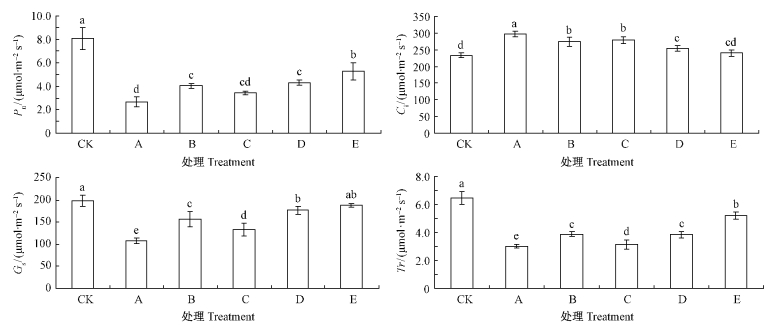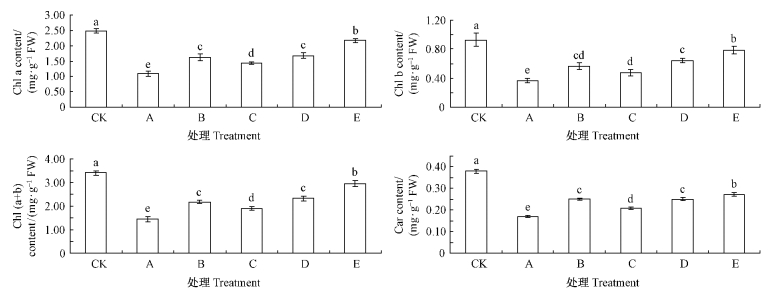文章信息
- 王艳芳, 潘凤兵, 张先富, 王鹏, 陈学森, 沈向, 毛志泉
- Wang Yanfang, Pan Fengbing, Zhang Xianfu, Wang Peng, Chen Xuesen, Shen Xiang, Mao Zhiquan
- 土壤中不同酚酸类物质对平邑甜茶幼苗光合及生理特性的影响
- Effects of Phenolic Acids on Growth and Photosynthetic Characteristics of Seedlings of Malus hupehensis
- 林业科学, 2015, 51(2): 52-59
- Scientia Silvae Sinicae, 2015, 51(2): 52-59.
- DOI: 10.11707/j.1001-7488.20150207
-
文章历史
- 收稿日期:2014-03-29
- 修回日期:2015-01-12
-
作者相关文章
2. 山东农业大学化学与材料科学学院 泰安 271018;
3. 泰安市河道管理局 泰安 271000
2. College of Chemistry and Material Science, Shandong Agricultural University Tai'an 271018;
3. Tai'an River Administration, Shandong Province Tan'an 271000
苹果连作(再植)常出现树势减弱、病虫害加重、品质变劣、果园寿命缩短等连作障碍现象,在世界各苹果主产区普遍发生(Tewoldemedhin et al., 2011),是制约苹果产业可持续发展的重要因素。引起苹果连作障碍的因素很多(Mazzola et al., 2012;Utkhede et al., 1992),其中酚酸类物质所引起的毒害作用是重要原因之一(Bai et al., 2009; Gao et al., 2010; Han et al., 2008)。张兆波等(2011)采用外源加入不同浓度的酚酸类物质进行盆栽试验,发现苯甲酸、咖啡酸等物质均抑制平邑甜茶幼苗植株生长。张江红等(2007)研究发现,低浓度的根皮苷促进平邑甜茶幼苗生长,高浓度的根皮苷则抑制幼苗生长。Yang等(2004)研究发现,阿魏酸、邻羟基苯乙酸和p-香豆酸均抑制水稻(Oryza sativa)叶片叶绿素的积累。用连作3年辣椒(Capsicum annuum)的土壤浸提液浇灌辣椒幼苗,导致幼苗叶片光合性能下降(张国斌等,2013)。
关于酚酸类物质对植物化感作用的研究,大多是人为设定酚酸类物质的浓度梯度进行植物伤害试验(吕德国等,2012),或者用土壤浸提液、根系分泌物进行综合伤害检测(Asaduzzaman et al., 2012;郭修武等,2010)。但在实际生产中,酚酸类物质的类型和含量在不同土壤类型、不同植物品种或品系间存在很大的差异,对植物的毒害作用是以其土壤中自然浓度发挥作用的(Inderjit et al., 2011; 张江红,2005)。连作果园土壤中实测浓度的酚酸类物质对植株生理特性的影响鲜见报道。因此本研究以生产上常用的苹果砧木——平邑甜茶(Malus hupehensis)为试验材料,在砂培条件下,用连作土壤中具有代表性的5种酚酸类物质处理平邑甜茶幼苗,通过研究其对平邑甜茶幼苗叶片的光合作用以及抗氧化性酶活、MDA含量、渗透物质含量等生理指标的影响,探讨连作土壤中实际浓度的不同酚酸类物质对平邑甜茶幼苗的伤害作用,以期为苹果连作障碍的防控措施提供理论依据。
1 材料与方法 1.1 试验材料以平邑甜茶为试材,试验于2013年在山东农业大学园艺科学与工程学院根系实验室进行,培养基质为河砂,砂石用水洗涤干净,备用。供试分析纯试剂根皮苷、根皮素、肉桂酸、对羟基苯甲酸、间苯三酚购自美国Sigma公司。
1.2 连作果园概况于山东省泰安市瓷窑镇大磨庄村选取1 334 m2 20年生红富士/八棱海棠(M. micromalus)苹果园,进行更新重建。土壤类型为褐土,土壤硝态氮含量为11.39 mg·kg-1,铵态氮含量为 2.32 mg·kg-1,速效钾含量为70.0 mg·kg-1,速效磷含量为25.4 mg·kg-1,有机质含量为5.1 g·kg-1。幼树为富士/平邑甜茶2年生嫁接苗,按照原树穴、原树株间、原树行间的布局进行栽植。果园连作幼树生长2年后,在新建苹果园中,从上述3个位置采用多点取样法取0~30 cm土层土壤混合,室温风干,过12目筛,用加速溶剂萃取法提取土壤中酚酸,然后用高效液相色谱仪分析酚酸类物质的含量(尹承苗等,2013)。经测定,5种酚酸类物质根皮苷、根皮素、肉桂酸、对羟基苯甲酸、间苯三酚的含量分别为6.0,0.05,0.06,0.3 mg,1.3 mg·kg-1。
用0.2%(v/v)乙醇溶液配制相应浓度的根皮苷、根皮素、肉桂酸、对羟基苯甲酸、间苯三酚溶液,备用。
1.3 试验方法将平邑甜茶种子层积、催芽后播种于高10 cm、直径10 cm的营养钵中(营养钵置于不漏水的托盘中),每钵6粒,待幼苗长出后,挑选长势基本一致的保留3株,每3天浇灌1次Hoagl and 营养液,每次50 mL,保证各处理条件一致。待幼苗长至10~11片功能叶后,选择长势基本一致的平邑甜茶幼苗进行处理,每处理12钵,重复3次。将上述浓度的5种酚酸溶液分别施入营养钵中,每5天处理1次,处理3次,每次20 mL,使营养钵中5种酚酸浓度分别达到连作果园土壤的浓度,以0.2%乙醇溶液为对照(CK)。第一1处理15天后,检测叶片的光合速率及各项生理指标。
1.4 相关指标的测定 1.4.1 气体交换参数的测定采用CIRAS-2 便携式光合系统(PPSystems,英国)于天气晴朗的上午测定气体交换参数,测定部位为从上数第4~5片功能叶中间,避开叶脉,每处理随机测定5株,3次重复。
1.4.2 叶绿素、丙二醛(MDA)、可溶性蛋白质以及脯氨酸含量的测定叶绿素、MDA含量的测定参照赵世杰等(2002)的方法,可溶性蛋白质含量采用考马斯亮蓝 G-250 染色法测定(李合生,2000),脯氨酸含量采用酸性茚三酮显色法测定(Kazemi et al., 2010)。
1.4.3 SOD,CAT,POD 活性的测定超氧化物歧化酶(SOD)活性的测定参照陈贻竹等(1988)的方法,过氧化物酶(POD)活性的测定采用Omran(1980)的方法,过氧化氢酶(CAT)活性的测定采用Kar等(1976)的方法。
1.5 统计分析采用Excel 2003软件完成对试验数据的计算和制图,通过SPSS 19.0软件进行方差分析,采用 Duncan’s 新复极差法进行差异显著性检测。
2 结果与分析 2.1 不同酚酸类物质对平邑甜茶幼苗干、鲜质量的影响由图 1可知,不同酚酸类物质均能使平邑甜茶幼苗植株干、鲜质量减小,其中以根皮苷处理对幼苗质量影响最大,植株鲜质量和干质量分别为对照的72.2%和61.4%;间苯三酚处理对幼苗影响最小,植株鲜质量和干质量分别为对照的92.6%和96.3%;而浓度最小的肉桂酸处理,对幼苗的影响却不是最小,植株的鲜质量和干质量分别为对照的79.6%和77.8%。
 |
图 1 不同酚酸对平邑甜茶幼苗干、鲜质量的影响 Fig. 1 Effects of different phenolic acids on the fresh weight and dry weight of Malus hupehensis seedling A: 根皮苷Phloridzin; B: 根皮素Phloretin; C: 肉桂酸Cinnamic acid; D: 对羟基苯甲酸p-hydroxybenzoic acid; E: 间苯三酚Phloroglucinol. 图中不同小写字母表示不同处理间的差异(P<0.05) Different letters in the figures stand for the significant difference at the 0. 05 level. 下同The same below. |
由图 2可知,5种酚酸类物质均导致平邑甜茶幼苗叶片净光合速率(Pn)降低,其中根皮苷处理对Pn影响最大,间苯三酚处理影响最小,根皮苷、根皮素、肉桂酸、对羟基苯甲酸和间苯三酚处理的Pn依次是对照的33.1%,49.9%,42.5%,53.3%和65.3%;平邑甜茶幼苗叶片的蒸腾速率(Tr)和气孔导度(Gs)的变化趋势与Pn一致;与对照相比,酚酸处理的幼苗叶片胞间CO2浓度(Ci)显著升高,其中以根皮苷处理升高幅度最大,间苯三酚处理升高幅度最少,分别升高27%和3%。
 |
图 2 不同酚酸对平邑甜茶幼苗叶片Pn,Ci,Gs和Tr的影响 Fig. 2 Effects of different phenolic acids on the Pn, Ci, Gs and Tr in leaves of M. hupehensis seedling |
由图 3可知,5种酚酸类物质均导致平邑甜茶幼苗叶片的Chl a,Chl b,Chl(a+b)以及类胡萝卜素含量降低。根皮苷、根皮素、肉桂酸、对羟基苯甲酸和间苯三酚处理后,幼苗叶片Chl(a+b)含量分别为对照的42.9%,64.0%,55.9%,68.2%和87.0%,类胡萝卜素含量分别为对照的44.6%,65.9%,54.8%,65.6%和71.4%。可见,根皮苷处理对叶片色素含量影响最大,间苯三酚处理影响最小。
 |
图 3 不同酚酸对平邑甜茶幼苗叶片色素的影响 Fig. 3 Effects of different phenolic acids on the pigment content in leaves of M. hupehensis seedling |
由图 4可知,5种酚酸类物质均导致平邑甜茶幼苗叶片抗氧化酶活性降低,各种酚酸处理的SOD活性由小到大的顺序依次是根皮苷<根皮素<对羟基苯甲酸<肉桂酸<间苯三酚<对照;POD活性由小到大的顺序与SOD活性顺序不同,肉桂酸处理的幼苗叶片的POD活性要小于对羟基苯甲酸处理。根皮苷处理的SOD和POD活性分别为对照的57%和40%,而间苯三酚处理的SOD和POD活性分别为对照的87%和88%。各种酚酸类物质处理的CAT活性大小顺序与SOD,POD活性顺序稍有不同,根皮素处理的CAT活性要大于肉桂酸处理而低于对羟基苯甲酸处理,根皮苷仍然是影响CAT活性最大的酚酸。
 |
图 4 不同酚酸对平邑甜茶幼苗叶片SOD,POD和CAT活性和MDA含量的影响 Fig. 4 Effects of different phenolic acids on SOD, POD and CAT activities and MDA content in leaves of M.hupehensis seedling |
5种酚酸类物质均可导致MDA的含量显著升高,各种酚酸处理的MDA含量由大到小的顺序依次是根皮苷>根皮素>对羟基苯甲酸>肉桂酸>间苯三酚>对照,根皮苷、肉桂酸和间苯三酚处理的MDA含量分别是对照的3.57,1.85和1.39倍。
2.5 不同酚酸类物质对平邑甜茶幼苗叶片脯氨酸和可溶性蛋白含量的影响由图 5可知,5种酚酸类物质均导致平邑甜茶幼苗叶片脯氨酸和可溶性蛋白含量升高。各种酚酸处理的脯氨酸和可溶性蛋白含量由大到小的顺序依次是根皮苷>根皮素>对羟基苯甲酸、肉桂酸>间苯三酚>对照,根皮苷、肉桂酸和间苯三酚处理的脯氨酸含量分别是对照的5.98,2.97和3.03倍,根皮苷、肉桂酸和间苯三酚处理的可溶性蛋白含量分别是对照的3.38,2.06和1.63倍。
 |
图 5 不同酚酸对平邑甜茶幼苗叶片脯氨酸和可溶性蛋白含量的影响 Fig. 5 Effects of different phenolic acids on the proline and soluble protein contents in leaves of M.hupehensis seedling |
植物受到酚酸类物质胁迫后,其形态和生长速率都会发生变化,酚酸类物质对植物的光合作用、植株保护性酶和膜透性、渗透物质含量、植物激素水平、蛋白质合成(王闯等,2009)以及干物质积累都有很大影响。
叶片光合色素在植物光合作用中起着极为重要的作用,其含量降低将导致光能吸收和传递受阻,最终引起光合速率下降(Li et al., 2003)。Nimbal等(1996)研究认为,化感物质能有效抑制PSⅡ中QA和QB之间的电子传递,进而影响光合作用。张江红等(2007)观察根皮苷对平邑甜茶幼苗叶片超微结构的影响时发现,高浓度根皮苷使幼苗叶片叶绿体的膜结构受到破坏,因此抑制苹果幼苗的光合作用。谭伟等(2012)研究乙草胺对葡萄(Vitis amurensis)叶片光合和叶绿素荧光特性及叶绿体结构的影响时发现,乙草胺处理的叶片叶绿体结构受损严重,叶绿体垛叠层变模糊,片层之间的间隙变大,水肿现象严重,叶绿体体积变小,导致叶绿素含量降低,光合速率下降。本研究中,施入根皮苷、根皮素、肉桂酸、对羟基苯甲酸和间苯三酚5种土壤浓度的酚酸类物质后,均使平邑甜茶幼苗叶片的Chl a、Chl b以及类胡萝卜素含量降低,并且净光合速率、蒸腾速率、气孔导度也明显低于对照,其中根皮苷处理降低程度最大,间苯三酚处理对平邑甜茶幼苗影响最小。这可能是因为酚酸类物质破坏了幼苗叶片叶绿体结构,使得叶绿体体积变小,叶绿素含量降低,抑制PSⅡ中QA和QB之间的电子传递,最终造成光合速率下降(Nimbal et al., 1996; 谭伟等,2012),不同的酚酸类物质对幼苗的影响程度大小不一,其中以根皮苷毒害程度最大。光合速率和气孔导度同向变化、而胞间二氧化碳浓度以相反方向变化时,表明限制光合作用的主要原因不在气孔(Farquhar et al., 1982),本研究中,酚酸类物质处理后,Pn与Gs降低的同时Ci上升,推测酚酸抑制平邑甜茶幼苗叶片光合速率的原因不在气孔。
MDA作为氧化伤害和脂质过氧化的主要产物,具有很强的毒性,可抑制蛋白质的合成或导致酶活性丧失,常用来衡量细胞膜脂过氧化程度和植株对逆境条件反应的强弱(李明等,2002)。本试验中,5种酚酸类物质胁迫均使平邑甜茶幼苗叶片内MDA含量大幅提高,其中根皮苷处理后,MDA含量为对照的3.57倍,而间苯三酚处理MDA含量为对照的1.39倍。可见,酚酸胁迫会对植株产生脂质过氧化作用,这与前人研究结果(Bai et al., 2009)相符。SOD,POD和CAT等保护酶能有效减轻活性氧和其他过氧化自由基对细胞膜脂的伤害,抑制膜脂过氧化,从而增强植物细胞对逆境胁迫的抵抗能力(Ahmad et al., 2010; Mittler,2002)。POD具有催化过氧化物和某些酚类物质分解的作用(王元征等,2011),SOD主要功能是清除体内的过氧负离子并产生H2O2,CAT具有清除过量积累的H2O2的作用,与SOD,POD一起保护膜系统免受自由基的伤害(Ashraf,2009)。连作是植物的一种逆境条件,会产生大量对植物有害的自由基,这些自由基一旦积累到一定程度,就会打破抗氧化酶系统和自由基之间的动态平衡进而对植物造成伤害(张兆波等,2011)。本试验中,5种酚酸类物质胁迫均使平邑甜茶幼苗叶片内SOD,POD和CAT活性降低,根皮苷处理幼苗叶片内保护酶活性降低最大,抗氧化酶活性受抑制程度大,其活性降低得多,清除自由基能力减弱,继而脂膜过氧化程度加重。酚酸类物质的毒害作用与作物连作障碍有很大的相关性,因此降低作物根系土壤中的酚酸类物质便可降低该类物质的毒害作用。近年来,利用芽孢杆菌(Bacillus spp.)、木霉(Trichoderma spp.)、假单胞菌(Pseudomonas spp.)等作为植物根际促生菌或拮抗菌缓解连作障碍取得了较大的进展,微生物降解是酚酸类物质在自然界中降解的一条有效途径,可通过降低作物根系土壤中酚酸类物质的浓度从而缓解其对植株产生的毒害作用。因此,运用有益微生物进行生物降解酚酸物质的研究越来越受到重视(叶素芬,2004;Zhang et al., 2010;李华玮等,2011;孙秀等,2014)。
植物适应外界不良环境胁迫的基本特征之一是渗透调节,脯氨酸、可溶性蛋白均为重要的渗透调节物质。在逆境条件下,脯氨酸的积累可能有适应意义,也可能是细胞结构受损的表现(汤章城,1984),是一种伤害反应。有研究发现渗透胁迫后,花生(Arachis hypogaea)叶片内各种渗透物质的含量均有不同程度的增加(张智猛等,2013),在重金属及盐碱胁迫下,二月兰(Orychophragmus violaceus)幼苗内渗透物质含量均呈上升趋势(张小艾等,2013)。本试验结果表明,在土壤浓度的酚酸胁迫下,平邑甜茶幼苗叶片的脯氨酸和可溶性蛋白含量明显增加,尤其是根皮苷处理后,幼苗叶片中脯氨酸和可溶性蛋白含量增加4.98和2.28倍,这一结果与Hanson等(1977)研究结果相一致,即脯氨酸的增加是胁迫对植物伤害的结果。
本试验中,低含量的肉桂酸对幼苗的伤害要比间苯三酚、根皮素、对羟基苯甲酸等大,这表明不同酚酸类物质对平邑甜茶幼苗的伤害能力大小不一,其中根皮苷对幼苗叶片色素含量、光合能力以及抗氧化系统的毒害作用最大,因此,对其降解或消除方法的研究很有实际意义,下一步将进行关于不同酚酸类物质对幼苗致害的临界值及各种酚酸类物质交互作用的探索研究。
| [1] |
陈贻竹, B. 帕特森. 1988. 低温对植物叶片中超氧物歧化酶, 过氧化氢酶和过氧化氢水平的影响. 植物生理与分子生物学学报, 14:323-328. (Chen Y Z, Patterson B D. 1988. The effect of chilling temperature on the level of superoxide dismutase, catalase and hydrogen peroxide in some plant leaves.Acta Phytophysiologica Sinica, 14: 323-328[in Chinese]).(  1) 1)
|
| [2] |
郭修武, 李 坤, 孙英妮, 等. 2010. 葡萄根系分泌物的化感效应及化感物质的分离鉴定. 园艺学报, 37 (6): 861-868. (Guo X W, Li K, Sun Y N, et al. 2010. Allelopathic effects and identification of allelochemicals in grape root excudates. Acta Horticulturae Sinica, 37(6): 861-868[in Chinese]).(  1) 1)
|
| [3] |
李合生. 2000. 植物生理生化实验原理和技术. 北京:高等教育出版社, 184-185. (Li H S. 2000. Principles and techniques of plant physiological biochemical experiment. Beijing: Higher Education Press, 184-185.[in Chinese])(  1) 1)
|
| [4] |
李华玮, 赵绪永, 李鹏坤. 2011. 作物连作障碍中酚酸类物质的生物降解研究, 中国农学通报, 27 (18):168-173. (Li H W, Zhao X Y, Li P K. 2011. Research on biodegradation effect to phenolic acid in even cook obstacles. Chinese Agricultural Science Bulletin, 27 (18):168-173[in Chinese]).(  1) 1)
|
| [5] |
李 明, 王根轩. 2002. 干旱胁迫对甘草幼苗保护酶活性及脂质过氧化作用的影响. 生态学报, 22 (4), 503-507. (Li M, Wang G X. 2002. Effect of drought stress on activities of cell defense enzymes and lipid peroxidation in Glycyrrhiza uralensis seedlings. Acta Ecologica Sinica, 22 (4): 503-507[in Chinese]).(  1) 1)
|
| [6] |
吕德国, 李志霞, 秦嗣军, 等. 2012. 酚类物质对东北山樱生长及呼吸关键酶的影响. 园艺学报, 39 (1):49-56. (Lü D G, Li Z X, Qin S J, et al. 2012. Effects of phenolic compounds on the growth and key enzymes in respiration of Cerasus sachalinensis. Acta Horticulturae Sinica, 39 (1): 49-56[in Chinese]).(  1) 1)
|
| [7] |
孙 秀, 王秀峰, 魏 珉, 等. 2014. 肉桂酸降解真菌的筛选及其降解液对黄瓜种子发芽的影响. 园艺学, 41(4):765-772. (Sun X, Wang X F, Wei M, et al. 2014. Screening and identification of cinnamic acid-degrading fungis and the effect of degradation liquid on the cucumber germination. Acta Horticulturae Sinica, 41(4):765-772[in Chinese]).(  1) 1)
|
| [8] |
谭 伟, 梁 婷, 翟 衡. 2012. 乙草胺对葡萄叶片光合和叶绿素荧光特性及叶绿体结构的影响. 应用生态学报, 23 (8): 2185-2190. (Tan W, Liang T, Zhai H. Effects of acetochlor on the photosynthetic and fluorescence characteristics and chloroplast structure of grape leaves. Chinese Journal of Applied Ecology, 23(8): 2185-2190[in Chinese]).(  2) 2)
|
| [9] |
汤章城. 1984. 逆境条件下植物脯氨酸的累积及其可能的意义. 植物生理学通讯, (1):15-21. (Tang Z C. 1984. The accumulation of proline and its possible significance under stress conditions. Plant Physiology Communications, (1):15-21[in Chinese]).(  1) 1)
|
| [10] |
王 闯, 徐公义, 葛长城, 等. 2009. 酚酸类物质和植物连作障碍的研究进展. 北方园艺, (3):134-137. (Wang C, Xu G Y, Ge C C, et al. 2009. Progress on the phenolic acid substances and plant soil sickness. Northern Horticulture, (3): 134-137[in Chinese]).(  1) 1)
|
| [11] |
王元征, 尹承苗, 陈 强, 等. 2011. 苹果5种砧木幼苗对连作土壤的适应性差异研究. 园艺学报, 38 (10): 1955-1962. (Wang Y Z, Yin C M, Chen Q, et al. Study on the difference of adaptability to replant soil in five apple rootstock seedlings. Acta Horticulturae Sinica, 38 (10): 1955-1962[in Chinese]).(  1) 1)
|
| [12] |
叶素芬. 2004. 黄瓜根系自毒物质对其根系病害的助长作用及其缓解机制研究. 杭州: 浙江大学博士学位论文. (Ye S F. 2004. Researeh on promotive effects of Fusarium wilt in Cueumis sativus by cinnamic acid, an autotoxin in root exudates of Cueumis sativus L., and mitigation mechanism by grafting and cinnamic acid-degrading microbial strains. Hangzhou: PhD thesis of Zhejiang University[in Chinese]).(  1) 1)
|
| [13] |
尹承苗, 王功帅, 李园园, 等. 2013. 一种分析土壤中酚酸类物质含量的新方法——以连作苹果园土壤为试材. 中国农业科学, 46(21): 4612-4619. (Yin C M, Wang G S, Li Y Y, et al. 2013. A new method for analysis of phenolic acids in the soil-soil from replanted spple orchards was investigated. Scientia Agricultura Sinica, 46 (21): 4612-4619[in Chinese]).(  1) 1)
|
| [14] |
张国斌, 郁继华, 冯 致, 等. 2013. NO和ABA对自毒作用下辣椒幼苗光合作用的影响. 中国农业科学, 46 (10):2076-2084. (Zhang G B, Yu J H, Feng Z, et al. 2013. Effects of exogenous nitric oxide and abscisic acid on photosynthesis characteristics in pepper seedlings under autotoxicity stress. Scientia Agricultura Sinica, 46 (10): 2076-2084[in Chinese]).(  1) 1)
|
| [15] |
张江红.2005. 酚类物质对苹果的化感作用及重茬障碍影响机理的研究. 泰安: 山东农业大学博士学位论文. (Zhang J H. 2005. Allelopathic effect of phenolics and its role on apple replant disease mechanism. Tai'an: PhD thesis of Shandong Agricultural University[in Chinese]).(  1) 1)
|
| [16] |
张江红, 毛志泉, 王丽琴, 等. 2007. 根皮苷对平邑甜茶幼苗生理特性的影响. 中国农业科学, 40 (3):492-498. (Zhang J H, Mao Z Q, Wang L Q, et al. 2007. Effect of phloridzin on physiological characteristics of Malus hupehensis Rehd. seedlings. Scientia Agricultura Sinica, 40 (3): 492-498[in Chinese]).(  2) 2)
|
| [17] |
张小艾, 李名扬, 汪志辉, 等. 2013. 重金属及盐碱对二月兰幼苗生长和生理生化的影响. 草业学报, 22 (2): 187-194. (Zhang X A, Li M Y, Wang Z H, et al. 2013. Effects of heavy metals and saline-alkali on seedlings growth, physiological- biochemical of Oryehophragmus violaeeus. Acta Prataculturae Sinica, 22 (2): 187-194[in Chinese]).(  1) 1)
|
| [18] |
张兆波, 毛志泉, 朱树华. 2011. 6种酚酸类物质对平邑甜茶幼苗根系线粒体及抗氧化酶活性的影响. 中国农业科学, 44 (15): 3177-3184. (Zhang Z B, Mao Z Q, Zhu S H. 2011. Effects of phenolic acids on mitochondria and the activityof antioxidant enzymes in roots of seedlings of Malus hupehensis Rehd. Scientia Agricultura Sinica, 44 (15): 3177-3184[in Chinese]).(  2) 2)
|
| [19] |
张智猛, 宋文武, 丁 红, 等. 2013. 不同生育期花生渗透调节物质含量和抗氧化酶活性对土壤水分的响应. 生态学报, 33 (14): 4257-4265. (Zhang Z M, Song W W, Ding H, et al. The responses of leaf osmoregulation substances and protective enzyme activity of different peanut cultivars to non-sufficient irrigation. Acta Ecologica Sinica, 33 (14): 4257-4265[in Chinese]).(  1) 1)
|
| [20] |
赵世杰, 史国安, 董新纯. 2002. 植物生理学试验指导. 北京: 中国农业科学技术出版社. (Zhao S J, Shi G A, Dong X C. 2002. Techniques of plant physiological experiment. Beijing: China Agricultural Science and Technology Press.[in Chinese])(  1) 1)
|
| [21] |
Ahmad P, Jaleel C A, Salem M A, et al. 2010. Roles of enzymatic and nonenzymatic antioxidants in plants during abiotic stress. Critical Reviews in Biotechnology, 30 (3): 161-175.( 1) 1)
|
| [22] |
Asaduzzaman M, Asao T. 2012. Autotoxicity in beans and their allelochemicals. Scientia Horticulturae, 134: 26-31.( 1) 1)
|
| [23] |
Ashraf M. 2009. Biotechnological approach of improving plant salt tolerance using antioxidants as markers. Biotechnology Advances, 27 (1): 84-93.( 1) 1)
|
| [24] |
Bai R, Ma F W, Liang D, Zhao X. 2009. Phthalic acid induces oxidative stress and alters the activity of some antioxidant enzymes in roots of Malus prunifolia. Journal of Chemical Ecology, 35 (4): 488-494.( 2) 2)
|
| [25] |
Farquhar G D, Sharkey T D. 1982. Stomatal conductance and photosynthesis. Annual Review of Plant Physiology, 33 (1): 317-345.( 1) 1)
|
| [26] |
Gao X B, Zhao F X, Shen X, et al. 2010. Effects of cinnamon acid on respiratory rate and its related enzymes activity in roots of seedlings of Malus hupehensis Rehd. Agricultural Sciences in China, 9 (6): 833-839.( 1) 1)
|
| [27] |
Han C M, Pan K, Wu N, et al. 2008. Allelopathic effect of ginger on seed germination and seedling growth of soybean and chive. Scientia Horticulturae, 116 (3): 330-336.( 1) 1)
|
| [28] |
Hanson A D, Nelsen C E, Everson E H. 1977. Evaluation of free proline accumulation as an index of drought resistance using two contrasting barley cultivars. Crop Science, 17 (5): 720-726.( 1) 1)
|
| [29] |
Inderjit, Wardle D A, Karban R, Callaway R M. 2011. The ecosystem and evolutionary contexts of allelopathy. Trends in Ecology & Evolution, 26: 655-662.( 1) 1)
|
| [30] |
Kar M, Mishra D. 1976. Catalase, peroxidase, and polyphenoloxidase activities during rice leaf senescence. Plant Physiology, 57 (2): 315-319.( 1) 1)
|
| [31] |
Kazemi, N, Khavari-Nejad R A, Fahimi H, et al. 2010. Effects of exogenous salicylic acid and nitric oxide on lipid peroxidation and antioxidant enzyme activities in leaves of Brassica napus L. under nickel stress. Scientia Horticulturae, 126: 402-407.( 1) 1)
|
| [32] |
Li X G, Meng Q W, Jiang G Q, et al. 2003. The susceptibility of cucumber and sweet pepper to chilling under low irradiance is related to energy dissipation and water-water cycle. Photosynthetica, 41 (2): 259-265.( 1) 1)
|
| [33] |
Mazzola M, Manici L M. 2012. Apple replant disease: role of microbial ecology in cause and control. Annual Review of Phytopathology, 50 (1): 45-65.( 1) 1)
|
| [34] |
Mittler R. 2002. Oxidative stress, antioxidants and stress tolerance. Trends in Plant Science, 7 (9): 405-410.( 1) 1)
|
| [35] |
Nimbal C I, Pedersen J F, Yerkes C N, et al. 1996. Phytotoxicity and distribution of sorgoleone in grain sorghum germplasm. Journal of Agricultural and Food Chemistry, 44 (5): 1343-1347.( 2) 2)
|
| [36] |
Omran R G. 1980. Peroxide levels and the activities of catalase, peroxidase, and indoleacetic acid oxidase during and after chilling cucumber seedlings. Plant Physiology, 65 (2): 407-408.( 1) 1)
|
| [37] |
Tewoldemedhin Y T, Mazzola M, Labuschagne I, et al. 2011. A multi-phasic approach reveals that apple replant disease is caused by multiple biological agents, with some agents acting synergistically. Soil Biology and Biochemistry, 43 (9): 1917-1927.( 1) 1)
|
| [38] |
Utkhede R, Vrain T, Yorston J. 1992. Effects of nematodes, fungi and bacteria on the growth of young apple trees grown in apple replant disease soil. Plant and Soil, 139 (1): 1-6.( 1) 1)
|
| [39] |
Yang C M, Chang I F, Lin S J, et al. 2004. Effects of three allelopathic phenolics on chlorophyll accumulation of rice (Oryza sativa) seedlings: II. Stimulation of consumption-orientation. Botanical Bulletin of Academia Sinica, 45: 119-125.( 1) 1)
|
| [40] |
Zhang Z Y, Pan L P, Li H H. 2010. Isolation, identification and characterization of soil microbes which degrade phenolic allelochemicals. Journal of Applied Microbiology, 108 (5):1839-1849.( 1) 1)
|
 2015, Vol. 51
2015, Vol. 51

